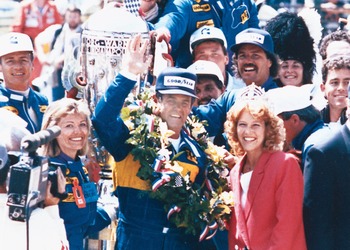Throwback Thursday - 1987 Indianapolis 500
June 9, 2016
Over the course of the 100 Indianapolis 500-mile races the list of victors, and those that came agonizingly close, are filled with amazing stories and colorful characters that helped make the race into “The Greatest Spectacle In Racing.” The 1987 event certainly had all of the defining qualities of a memorable race: the winningest team in race history, a driver from the most-famous family in open-wheel racing trying to win his fourth race as a substitute driver, and car pulled from an unlikely location to be thrust into duty.
Team Penske and the Indy 500 fit together like a hand and glove. The organization has won a total of 16 Indy 500s, the most in history. If the 1970s were the decade where Roger Penske first tasted success at the Brickyard, the 1980s were the decade when his team became the dominant force. When the team entered the gates for the 1987 event they had five Indy 500 wins in their possession, three since the turn of the decade.
The three-car lineup that Team Penske planned to enter in that year’s Indy 500 consisted of two-time winner Rick Mears, 1985 winner Danny Sullivan and veteran Danny Ongais. Al Unser, Sr., a three-time winner of the event, had retired from full-time driving – at Team Penske – the previous year and showed up at Indianapolis Motor Speedway unemployed for the race.
Early in the fifth day of practice for the race, on May 7, Ongais crashed hard into the outside wall in turn four and was sidelined for the rest of the month. In addition, Team Penske decided to park their PC-16 chassis in favor of their stable of 1986 March chassis. The first one would not be delivered until the next day, and Mears and Sullivan flipped a coin to see who would drive it. Mears won the toss.
Qualifying for the race began on Saturday, May 9, with Team Penske still having no replacement for Ongais. Though Mears had the new March up to speed, Sullivan had to qualify the PC-16. Both made it safely into the field, but talks were taking place for Sullivan to re-qualify a March chassis the next weekend when it arrived at the speedway.
On Wednesday, May 13, Unser, Sr. was officially named the replacement for Ongais. Unser, Sr. had contemplated returning to his home in Albuquerque after not finding a ride earlier in the month, but chose to stick around to help his son, Al Unser, Jr., prepare for the race. Team Penske officials began scouring their fleet of potential Marches to find a suitable entry for Unser, Sr.
The chosen chassis came from the lobby of a Sheraton hotel in Reading, PA, where it was being used as a showcar. In typical Team Penske fashion, the crew of the No. 25 team whipped the chassis into shape and Unser, Sr. was given an opportunity to win his fourth Indy 500, which would tie A.J. Foyt for the most all-time.
With Mears starting third, Sullivan 16th and Unser, Sr. 20th, Team Penske had cars scattered throughout the 33-car field for the 1987 Indy 500. Continuing with the theme of the month, the attrition rate was high during the race. Mears retired at lap 75 with a coil wire and Sullivan did the same at lap 160 with an engine issue.
All the while, Unser, Sr. took care of his equipment as he worked his way through the field, although Mario Andretti looked unbeatable as he set a blistering pace. By the 90th lap, Unser, Sr. had worked his way into the top five, but he was two laps down to the fast Andretti.
However, with 25 laps remaining, Andretti retired from the event with a fuel injection issue, handing the lead over to Roberto Guerrero. Guerrero’s lead over the now second-place Unser, Sr. was almost a full lap, but he had to make one final pit stop whereas the No. 25 team had called Unser, Sr. in earlier.
With 18 laps to go, Guerrero made his way down pit road, but clutch issues turned the routine service into a disaster. He watched from pit road as Unser sailed by to take the lead, eventually putting Guerrero almost a lap down. From there, Al Unser, Sr. cruised to his fourth Indy 500 win. At 47 years of age he became the oldest winner in race history.
What if he had returned to Albuquerque instead of hanging around 16th and Georgetown? What if the Team Penske crew couldn’t prepare a showcar in time for him to compete? Indy 500 history may look a lot different than it does today.

